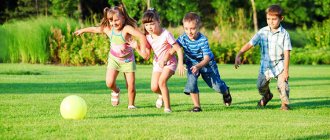A walk to the preschool educational institution. Kinds
The importance of walking for the health of preschool children
Author: Burobina Nina Valerievna, senior teacher of the preschool educational institution “Kindergarten No. 4” in the city of Mikhailov. A child’s systematic active stay in the fresh air is one of the main factors in full physical development. A walk of any direction is also effective as an accessible way to harden a fragile child’s body, helps build resistance to colds, and improves immunity. The main activities of preschoolers during a walk are outdoor games, which have a beneficial effect on the development of the circulatory, respiratory, musculoskeletal systems, and improves appetite. Using those located on the playground, children, during independent play activities, learn to overcome obstacles, coordinate movements, and develop the vestibular apparatus. Children acquire new skills, motor skills, become brave, dexterous, and resilient. In addition, during a walk, the child naturally learns about the world around him and gains new knowledge.
Basic requirements for the duration of a walk in kindergarten
In optimal weather conditions, the walk is carried out twice a day. The first trip outside takes place immediately after classes, the second - after afternoon tea. The teacher regulates the duration of the walk in accordance with climatic conditions, the total walk time recommended by sanitary standards is 4 hours. At air temperatures below -15 and wind speeds of more than 7 m/s, the walk time is reduced. Winds of more than 15 m/s, precipitation, and extremely low air temperatures are grounds for prohibiting going out for a walk. During the summer healing period, it is recommended to use any opportunities for walks in the fresh air; stay in the group room is limited to sleep and meals. The time for going out for a walk is determined by teachers independently, in accordance with the regime of the educational process for children of different age groups.
Depending on the location, walks are divided into several types:
1. Walks on the territory of the preschool educational institution. 2. Walking outside the perimeter of the institution. 3. Walks in the functional premises of the kindergarten (canopies, verandas), in bad weather.
According to their focus, walks have the following categories:
1) traditional; 2) targeted (with going beyond the subsidiaries); 3) thematic; 4) excursion.
Features of a targeted walk
Organizing a targeted walk requires the teacher to have certain organizational skills and spend time preparing and completing documentation. Exit outside the kindergarten is not carried out without the consent of parents, approval of the route by the administration at the request of the leader of the walk, indicating the number of pupils accompanying. The developmental significance of going beyond limits for very young children is great. Under the strict guidance of a mentor, they observe natural phenomena and social life. Active walking builds endurance and has a beneficial effect on physical development. It is recommended that children of the younger group be taken outside near the preschool educational institution once a week. The teacher shows them houses, transport, people on foot. For children in the middle group, the purpose of public buildings is explained: schools, recreation centers, hospitals. The older children are taken for long walks around the locality where the kindergarten is located twice a week. Walks to neighboring streets and parks introduce children to the rules of behavior in public places, the peculiarities of traffic and pedestrians. Targeted walks help broaden the pupils' horizons, develop curiosity and observation. Children's knowledge and ideas about the world around them are deepened on the basis of empirical, direct perception; they are not imposed from above and do not cause protest, which is very valuable in the sense of preserving the special psychological world of a preschool child.
Structural parts of a walk in a preschool educational institution:
1. Observation.
2. Outdoor games. 3. Individual work of the teacher with children. 4. Children's labor on the site. 5. Independent play activity. The components of the walk can vary depending on the mood of the children, weather conditions, and the nature of previous activities. Each type of activity lasts 7-15 minutes, and then is replaced by another against the backdrop of independent activity of the students. It is prohibited: 1. Leaving children alone, unattended by employees of the Institution. 2. Use sharp, piercing, cutting objects and broken toys in children's games.
We recommend watching:
Organization of walks in the preparatory group. Walks in the summer with older preschoolers. Consultations for teachers. Organization of walks - hikes with preschoolers in nature. Themed walks in kindergarten. Middle group
Similar articles:
Organization of a walk in the junior group according to the Federal State Educational Standard
Observations of wildlife in the younger group of kindergarten
Observations of inanimate nature on a walk in the younger group
Observations of the work of adults in the younger group
Observations of street life. Junior group
Analytical report on conducting sampling control “Organization and conduct of a walk”
| REPUBLIC OF CRIMEA DZHANKOYSKY AREA | REPUBLIC OF CRIMEA DZHANKOYSKY AREA Municipal preschool educational institution "May kindergarten "Solnyshko" | KYRYM DZUMHURIETI JANKOY BOLYUGI |
Pushkin street 56, Mayskoye village, Dzhankoy district, Republic of Crimea, Russian Federation, 296178
tel.:(06564)50-3-08 , e-mail:
Analytical information
about carrying out sampling control
"Organization and conduct of a walk"
According to the annual work plan of the MDOU "May kindergarten "Solnyshko" for the 2022 - 2022 academic year, in accordance with order No. 128-OD dated 08/30/2019 "Organization and conduct of a walk", in the period from 09/13/2019 to 09/30. 2019, a sample control was carried out by the senior teacher of the MDOU Popkova I.P.
Purpose of control:
identifying the quality of organizing walks with preschool children and determining the prospects for development in this direction. Teachers’ compliance with children’s physical activity regime in the fresh air.
Test methods:
-Analysis of teachers’ work schedules.
-Conversations with teachers.
-Observations of children.
-Analysis of children’s activities during walks in all age groups.
Senior teacher Popkova I.P. the documentation of teachers reflecting the organization of children's walks was analyzed; the commission observed compliance with the daily routine, organization of preparation for the walk and return to the group, education of cultural and hygienic skills of children during the walk; Walks were attended, as well as children's health activities.
During the control it was revealed:
Teachers: Dusmambetova D.A., Gafarova L.R., Dorman O.P., Asanova Z.R., Zeynalieva N.R., Eroshkina N.A. are conscientious about planning outings. The calendar plans indicate all types of children's activities during the walk. The groups have files of walks and observations in nature. The emotional background of the walk is positive, the teachers have knowledge of the developmental psychology of children, use a personality-oriented approach to the students, most often use request, approval, praise, and encourage the students. Remarks and reproaches are fair and emotionally positive.
The walking regimen is observed and implemented by teachers in accordance with the daily routine of each age group, SanPiN 2.4.1.3049-13 and weather conditions.
Based on weather conditions, teachers organize active and sedentary games. The motor mode during the walk is generally observed. During the walk, the teacher implemented all its parts. The teacher changed the sequence of these components. An outdoor game was carried out at the beginning of the walk due to the children sitting for a long time during the lesson. The outdoor game corresponds to the age of the children and the season (it was carried out on a warm autumn day). This game was familiar to children. The teacher only helped me remember the rules. And during the game I monitored their precise implementation. The teacher developed the children’s ability to adapt to changing circumstances. The first leader was chosen with a counting rhyme, which the children readily offered. Next, the leader was chosen by the teacher. The choice fell on the child, in whom the teacher was confident that he would accurately cope with the assigned role. The game was repeated 4 times. The children happily gathered to play an already familiar and, apparently, forgotten game. This game does not require any attributes.
Teachers spend a lot of time on walks observing (pre-planned) observations of natural phenomena and social life. Observations can be carried out with a whole group of children, with subgroups, as well as with individual children. The topic and object of observation correspond to the age of the children (observation of an autumn tree). The object of observation (autumn tree) was visible to all children, and everyone was given the opportunity to examine it. The teacher drew the children's attention to the mood of the tree, its branches, leaves, etc. The children were interested in this topic of the walk. This was evident from the questions asked and the concentrated attention on the object of observation. The questions of many children were the following: “Why do the leaves turn yellow?”, “How do trees drink water?” Riddles and a poem helped the teacher arouse interest in the children.
The groups have a sufficient amount of takeaway material for the season. However, it was not possible to see role-playing games organized by teachers and individual work with children.
Little attention is paid to developing children's ideas about the usefulness and appropriateness of physical activity, and attracting the attention of parents to this issue.
Children in these groups have developed self-care skills appropriate to their age.
To create a holistic system of physical education and health work during a walk, the organization of a motor development environment is very important.
An analysis of the created conditions showed that to organize the motor activity of children during a walk, there are slides, horizontal bars, swings, small architectural forms, gymnastic beams, balance beams, and landmarks for throwing at a target. Pavilions are used for walks in any weather.
The groups have take-out material as a necessary attribute for increasing the physical activity of children: flags, plumes, ribbons, hoops, jump ropes, sandbags, balls, ring throws, skittles, as well as manuals made by teachers, which also increase interest in physical activity , contribute to the health of children, take into account the age characteristics of children and their interests.
However, teachers do not fully use these attributes when organizing motor activities with children.
Teachers of controlled groups daily plan outdoor games and individual work during walks, while teachers play little with children, often use already familiar games, do not learn new games enough, and complications are not used. Hiking trips are planned, but are carried out extremely rarely.
Work activity while walking is of great educational importance. During the walk, the teachers used household work. All work assignments corresponded to the age of the children. The children were able to carry out their work tasks and performed them with pleasure. Since the teachers used various nursery rhymes in the process. The children removed dry branches from the area. To carry out their work activities, the teacher gave them gloves and indicated why they needed to wear them. The children were satisfied with the results of their work and willingly shared their impressions of the work done with the teacher.
During the walk, teachers carried out individual work with children, because work on movement development. Teacher Dusmambetova D.A. I worked with a group of 5 children to improve jumping on two legs with an object clamped between the feet. For this, the teacher used balls. The teacher chose the children based on their level of physical fitness in order to consolidate this type of jumping. The results of the work done were obvious. The teacher was pleased with the quality of her performance.
The teachers warned the children about this a few minutes before the end of the walk. The children were reminded to collect their toys and equipment. Then she indicated that the children should stand in a column in pairs (a boy and a girl). When the children went to the group, teacher Dorman O.P. made a small conclusion by asking questions to the children: “Who were they watching today,” “Did they enjoy the walk,” etc. Before entering the premises, N.R. Zeinalieva. reminded the children about the need to wipe their feet and how to behave. In the dressing room, the teacher and assistant teacher made sure that all the children changed clothes and provided the necessary assistance. Then all the children washed their hands and sat down to dinner.
Teachers of all groups of preschool educational institutions complied with safety requirements when organizing walks in the kindergarten area. It is very important that every child is prepared to face various difficult and sometimes dangerous life situations. Children must act consciously in a given environment. Teachers know that preschoolers must develop independence and responsibility so that they can always act adequately in dangerous moments in their lives. After all, when faced with a dangerous situation, children begin to solve it by trial and error. Therefore, already in kindergarten it is important to create conditions that will help to accumulate experience in safe behavior. The most effective educational didactic games. When playing such games, children learn to remember their actions during the game and analyze the results. In the didactic game, knowledge about sources of danger, precautions, actions in dangerous situations is formed, and knowledge about providing first aid is formed.
Recommendations and suggestions:
1. Teachers of all age groups should prepare more carefully for the walk.
Timing: constantly
Responsible: preschool teachers
2.Teachers of all age groups organize role-playing games and individual work with children, according to planning.
Timing: constantly
Responsible: preschool teachers
3. Educators of all age groups, when guiding the independent activities of children during a walk, use the necessary attributes and take-out material to increase the motor activity of children.
Timing: constantly
Responsible: preschool teachers
4. Educators of all age groups should play more during walks, learn new outdoor games and play situations with children, and use complications.
Timing: constantly
Responsible: preschool teachers
5. Teachers of the first junior group and the second junior group should diversify the motor mode during walks, conduct active and sedentary games based on the age characteristics of the children.
Deadline: until the end of the academic year
Responsible: teachers of the first junior group, second junior group.
6. To ensure optimal physical activity of children in the fresh air, educators of all age groups should systematize and follow the structure of walks in the afternoon.
Timing: constantly, depending on weather conditions
Responsible: preschool teachers
Responsible for monitoring: senior teacher Popkova I.P.
The certificate was compiled by _________ Popkova I.P.
Head of MDOU
“May kindergarten “Sunny” ______________ Matveeva L.O.
09/30/2019
The importance of walking for preschool children
The main part of the excursion is collective observation. The main tasks are solved here. The teacher helps children notice and understand the characteristic signs of objects and phenomena. This is achieved using various techniques (questions, riddles, poems, survey activities, game techniques). The teacher supplements the observations with his story and explanation.
It is useful to use children's fiction in the observation process. At the end of the main part, children must be given the opportunity to satisfy their curiosity in individual and independent observations and collection of natural history material. However, when giving the task to collect material, you should strictly limit its quantity in order to focus the children’s attention only on certain plants or animals, in addition, to solve the problem of caring for nature.
During rest, the collected material is sorted, laid out, and used for games and exercises. In games: “recognize by smell”, “recognize by description”, “find a plant by leaf”, “branch, branch, where is your baby?” - children consolidate knowledge about the characteristic features of objects, express their quality in words, remember the names of plants and their parts.
Agricultural excursions are varied: to the field, to the meadow, to the garden, to the vegetable garden, to the greenhouse, etc. Such excursions provide an opportunity to clearly show how humans influence nature, how they grow plants and animals. The uniqueness of these excursions is that the child can observe both human activity and the nature on which he influences.
Excursions to agricultural sites begin with a preliminary conversation. At the end of the excursion, impressions of working at the bottom object are summarized.
When conducting walks, excursions, and targeted walks with children, teachers must follow certain safety rules:
Firstly, outline and check the route of the future walk in advance, inspect the area, the route of movement of the pupils for the purpose of their safe stay outside the preschool educational institution; The route is approved by the head of the preschool educational institution.
Secondly, the content of the event is clearly planned and the appropriate equipment is selected. The set of necessary equipment includes light individual backpacks, fresh drinking water, disposable cups for the number of children and adults, soap, napkins, attributes for organizing educational games and independent activities for preschoolers. In case you need to clean up the parking area, it is worth taking small rakes, shovels and garbage bags with you.
Thirdly, be sure to have a first aid kit. Every adult accompanying a group of children must know its contents well and be able to use it.
In all other cases, our students must go for walks several times a day. The organization of walks in the English Garden kindergarten occupies an important place in the formation of children's daily routine, since it affects various manifestations of their activity and the functioning of the body.
The benefits of walking for children
Outdoor activities in kindergarten bring the following benefits to children:
- Health promotion. Active movements in the fresh air lead to children becoming much fitter, stronger and more energetic.
- Development of endurance. Walking is a kind of training in which the load is evenly distributed over the entire body. Not only the muscles and bones of the skeleton are strengthened, but also the cardiovascular and nervous systems. Kids get tired less, which has a positive effect on their perseverance and ability to successfully assimilate information.
- Improved metabolism. Mobility and fresh air have a positive effect on appetite and the absorption of nutrients from food. Our kindergarten in a cottage village has all the conditions to improve the health of its pupils.
- Hardening the body. Walking in almost any weather helps strengthen and strengthen the immune system, but parents definitely need to dress their children according to the weather, and not according to the season. Overheating is no less dangerous than hypothermia.
- Reduced morbidity. Having become accustomed to different weather conditions, the child gets colds and illnesses less often, and this has a positive effect on his upbringing and studies in kindergarten. Good health will also be a positive thing when a child moves from kindergarten to primary school - there will be less absenteeism.
It is also equally important how long children spend in kindergarten. The duration of stay in the fresh air should be at least one and a half hours. Our bilingual kindergarten in Krasnogorsk has all the conditions and amenities for long and useful walks. The little ones have a comfortable and practical playground, fully equipped for preschool children. In addition, the village of Krasnogorskaya Usadba, where our kindergarten is located, is located in an ecologically clean area of the Moscow region in close proximity to a reservoir and a green area.
The effect of walking in the fresh air on neutralizing negative emotions
Children's games in the fresh air have a positive effect on the developing child's psyche, neutralizing negative emotions. Being on the street leads to inhibition of the functions of that part of the child’s brain that is responsible for aggression, irritation and negativity. Regular walks help reduce stress, making children feel better, calmer, more reasonable and confident.
A modern private kindergarten in Krasnogorsk, English Garden, pays a lot of attention to organizing children’s time in the fresh air, as well as outdoor games, walks and entertainment.
Thanks to this, our pupils enjoy going for walks in any weather and look forward to the opportunity to go out into the courtyard of a cozy kindergarten, where they have their favorite places and interesting games.
0



